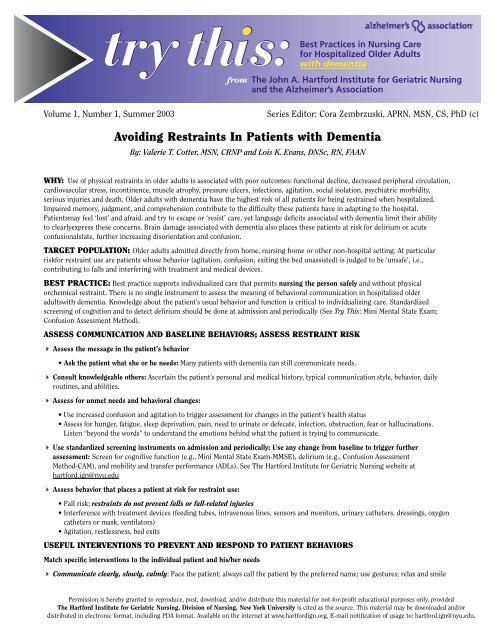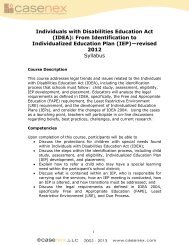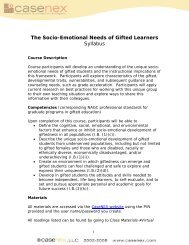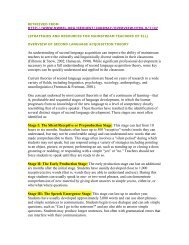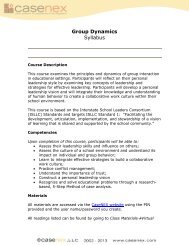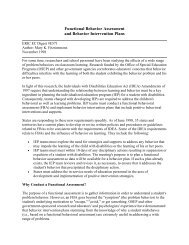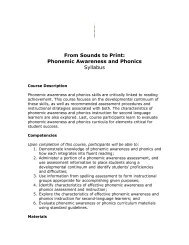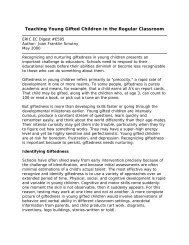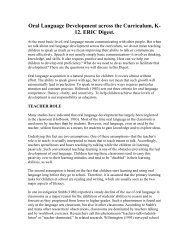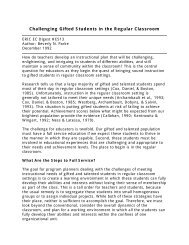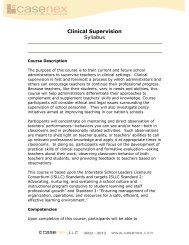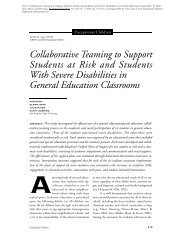Avoiding Restraints In Patients with Dementia - Casenex
Avoiding Restraints In Patients with Dementia - Casenex
Avoiding Restraints In Patients with Dementia - Casenex
Create successful ePaper yourself
Turn your PDF publications into a flip-book with our unique Google optimized e-Paper software.
Volume 1, Number 1, Summer 2003<br />
Series Editor: Cora Zembrzuski, APRN, MSN, CS, PhD (c)<br />
<strong>Avoiding</strong> <strong>Restraints</strong> <strong>In</strong> <strong>Patients</strong> <strong>with</strong> <strong>Dementia</strong><br />
By: Valerie T. Cotter, MSN, CRNP and Lois K. Evans, DNSc, RN, FAAN<br />
WHY: Use of physical restraints in older adults is associated <strong>with</strong> poor outcomes: functional decline, decreased peripheral circulation,<br />
cardiovascular stress, incontinence, muscle atrophy, pressure ulcers, infections, agitation, social isolation, psychiatric morbidity,<br />
serious injuries and death. Older adults <strong>with</strong> dementia have the highest risk of all patients for being restrained when hospitalized.<br />
Impaired memory, judgment, and comprehension contribute to the difficulty these patients have in adapting to the hospital.<br />
<strong>Patients</strong>may feel ‘lost’ and afraid, and try to escape or ‘resist’ care, yet language deficits associated <strong>with</strong> dementia limit their ability<br />
to clearlyexpress these concerns. Brain damage associated <strong>with</strong> dementia also places these patients at risk for delirium or acute<br />
confusionalstate, further increasing disorientation and confusion.<br />
TARGET POPULATION: Older adults admitted directly from home, nursing home or other non-hospital setting. At particular<br />
riskfor restraint use are patients whose behavior (agitation, confusion, exiting the bed unassisted) is judged to be ‘unsafe’, i.e.,<br />
contributing to falls and interfering <strong>with</strong> treatment and medical devices.<br />
BEST PRACTICE: Best practice supports individualized care that permits nursing the person safely and <strong>with</strong>out physical<br />
orchemical restraint. There is no single instrument to assess the meaning of behavioral communication in hospitalized older<br />
adults<strong>with</strong> dementia. Knowledge about the patient’s usual behavior and function is critical to individualizing care. Standardized<br />
screening of cognition and to detect delirium should be done at admission and periodically (See Try This: Mini Mental State Exam;<br />
Confusion Assessment Method).<br />
ASSESS COMMUNICATION AND BASELINE BEHAVIORS; ASSESS RESTRAINT RISK<br />
4 Assess the message in the patient’s behavior<br />
• Ask the patient what she or he needs: Many patients <strong>with</strong> dementia can still communicate needs.<br />
4 Consult knowledgeable others: Ascertain the patient’s personal and medical history, typical communication style, behavior, daily<br />
routines, and abilities.<br />
4 Assess for unmet needs and behavioral changes:<br />
• Use increased confusion and agitation to trigger assessment for changes in the patient’s health status<br />
• Assess for hunger, fatigue, sleep deprivation, pain, need to urinate or defecate, infection, obstruction, fear or hallucinations.<br />
Listen “beyond the words” to understand the emotions behind what the patient is trying to communicate.<br />
4 Use standardized screening instruments on admission and periodically; Use any change from baseline to trigger further<br />
assessment: Screen for cognitive function (e.g., Mini Mental State Exam-MMSE), delirium (e.g., Confusion Assessment<br />
Method-CAM), and mobility and transfer performance (ADLs). See The Hartford <strong>In</strong>stitute for Geriatric Nursing website at<br />
hartford.ign@nyu.edu<br />
4 Assess behavior that places a patient at risk for restraint use:<br />
• Fall risk; restraints do not prevent falls or fall-related injuries<br />
• <strong>In</strong>terference <strong>with</strong> treatment devices (feeding tubes, intravenous lines, sensors and monitors, urinary catheters, dressings, oxygen<br />
catheters or mask, ventilators)<br />
• Agitation, restlessness, bed exits<br />
USEFUL INTERVENTIONS TO PREVENT AND RESPOND TO PATIENT BEHAVIORS<br />
Match specific interventions to the individual patient and his/her needs<br />
4 Communicate clearly, slowly, calmly: Face the patient; always call the patient by the preferred name; use gestures; relax and smile<br />
Permission is hereby granted to reproduce, post, download, and/or distribute this material for not-for-profit educational purposes only, provided<br />
The Hartford <strong>In</strong>stitute for Geriatric Nursing, Division of Nursing, New York University is cited as the source. This material may be downloaded and/or<br />
distributed in electronic format, including PDA format. Available on the internet at www.hartfordign.org. E-mail notification of usage to: hartford.ign@nyu.edu.
4 Remove bedside rails or use only half rails; remove restraints<br />
4 Understand the patient’s reason for attempting bed exit: Most often, it is a need to toilet. Anticipate and meet needs by<br />
individualized elimination routine based on the patient’s history.<br />
4 Attend to bed safety: Lower height, alarms, bed-boundary markers, trapeze or transfer enabler.<br />
• Remember, an alarm system is merely an alert for a potential emergency.<br />
• Identify all patients on each shift that have bed alarms<br />
4 Attend to chair and wheelchair safety: Use portable chair alarms<br />
4 Protect against falls and injuries<br />
• Provide night light in bathroom<br />
• Preserve function <strong>with</strong> daily weight-bearing, comfortable seating, ambulation devices at the bedside<br />
• Provide non-skid slippers<br />
• Place fall risk “alert” on the bed or door frame<br />
• Be especially alert at change of shift times<br />
4 Modify the immediate environment:<br />
• Reduce excessive noise and activity (TV off unless patient requests)<br />
• Provide for interaction <strong>with</strong> and visualization of and by others<br />
• Provide appropriate light levels<br />
• Remove confusing art or other objects<br />
4 Provide surveillance: Move patient closer to nursing station or to a room <strong>with</strong> a window to the hallway; use monitors<br />
4 Reassess need for invasive treatment devices<br />
• Use the Least <strong>In</strong>vasive Method to Deliver Care<br />
• Repeatedly use verbal explanation, guided exploration and a mirror: Help the patient understand what is in place and why<br />
• Provide comfort care to the site: Oral/nasal care, anchoring of tubing<br />
• Use camouflage: Clothing or elastic sleeves, temporary air splint<br />
• Provide diversionary activities: Something to hold and squeeze; favorite music in a headset<br />
• Discontinue invasive treatments as early as possible<br />
4 Provide for ‘familiarity’: Encourage use of family photographs, favorite personal mementos, audiotapes of family members.<br />
Assign the same staff to the extent possible.<br />
4 Encourage family and familiar others to participate in care: Frequent visiting, ADL assistance, and remaining at the bedside<br />
around the clock for 1-2 days post admission and/or during the evening<br />
4 Strive for consistency of personnel, normal function and usual routines, e.g., toileting, eating, and personal hygiene care<br />
ORGANIZATIONAL STRUCTURE TO SUPPORT RESTRAINT-FREE CAREE<br />
4 Establish a Restraint Reduction committee<br />
4 Review the organization’s mission statement, policies; assure committed leadership<br />
4 Use geriatric advanced practice nurses, physicians, and interdisciplinary team consultation for complex patientpresentations<br />
4 Provide staff education; consistent staff assignment; access to supportive equipment; technology to support reliable admission<br />
data and communication of care strategies<br />
4 Review pain evaluation and treatment protocols<br />
4 Test patient interventions through continuous quality improvement (CQI)<br />
REFERENCES:<br />
Capezuti, E., Talerico, K.A., Cochran, I., Becker, H., Strumpf, N., & Evans, L. (1999). <strong>In</strong>dividualized interventions to prevent<br />
bed-related falls and reduce siderail use. Journal of Gerontological Nursing, 25(11), 26-34.<br />
DeProspero, P., & Bocchino, N.L. (1999). Restraint-free care: Is it possible? American Journal of Nursing, 99(10), 26-33.<br />
Strumpf, N.E., Robinson, J.P., Wagner, J.S., & Evans, L.K. (1998). Restraint-free care, New York: Springer.<br />
Sullivan-Marx, E.M. (2001). Achieving restraint-free care of acutely confused older adults. Journal of Gerontological<br />
Nursing, 27(4), 56-61.<br />
A series provided by<br />
The Hartford <strong>In</strong>stitute for Geriatric Nursing<br />
and the Alzheimer’s Association<br />
www.hartfordign.org


